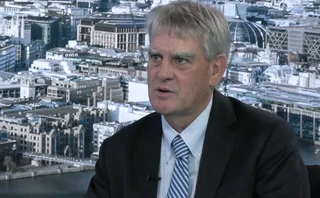
Europe house of the year: Societe Generale
Structured Product Europe Awards 2017: From the electronification of its advisory business to the creation of structured instruments that mimic OTC swap strategies, SG is leading across the board

Societe Generale has racked up some serious numbers in 2017. According to its in-house data, SG issued €22 billion ($26 billion) of structured notes across all asset classes in Europe during the past 12 months, which is 40% up on the same period year-on-year. The bank sold 150,000 individual tickets in the first half of 2017, which represented a 33% year-on-year increase.
Lightly exotic products have racked up €6 billion of sales in 2017 so far, which is 40% more than in 2016. It is the equity market that is largely responsible for these numbers. As stock markets have rallied, there has been a clamour from investors from all stripes to acquire exposure to equities. While sluggish equity markets last year meant autocallable notes were rarely knocked out, the trend has been reversed this year. Indeed, the surge in issuance is largely attributable to the refinancing of called notes.
As one judge comments: “From an ideas-generation perspective, I think SG has proven that they are best in class, but they provide ideas that are very specific to their clients and investors. They are always creative in pricing adaptation and they have the talent to solve and turnaround problems quickly.”
While equity markets have boomed, volumes in credit markets have fallen slightly. But the presentation of appealing equity-linked trades and structures had to be accomplished in the face of volatility which was lower than anyone can remember.
“Low rates has been a given for a number of years, but low vol is something new,” says Jean-Francois Mastrangelo, head of pricing and development for Europe at SG. “Since the summer, it has been at depths which we have never seen before. But it is our job to adapt to circumstances and find new opportunities for our clients based on these.”
Various solutions were offered by SG to get investors a bigger bang for their buck. The bank sold hybrid products that provide equity exposure combined with exposure to credits or credit events. For example, it has raised more than £500 million ($658 million) in four UK investment plans, designed for independent financial advisers, in which redemption is linked to the credit of Aviva, Barclays, HSBC and Lloyds. This removes the SG counterparty risk and bumps the coupon levels for autocallables.
Perhaps the most innovative strategy has been to offer institutional buyers exposure to liquid equity indexes and augment coupon levels by harvesting the spread between implied vol and actual vol. By selling actual vol at the level of implied vol, which was generally higher over the year, the risk premia could be captured. Moreover, SG adopted a dynamic delta-hedging policy, which avoided rebalancing the hedge when execution costs were generally higher.
It is our job to adapt to circumstances and find new opportunities for our clients
Jean-Francois Mastrangelo, Societe Generale
The bank has also been helped by the fact that buyers are willing to take on more risk and execute less familiar strategies in an effort to acquire more yield. Asset managers, for instance, have had to think creatively to find yield in the low vol environment.
To make the process easier for them, SG has begun to securitise derivatives products into a note form in both the equity and fixed-income markets. This simplifies the products substantially and encourages participation from clients that have previously eschewed derivatives instruments for any number of reasons, such as resistance to the margin call, the absence of required documentation or suitable management structures. The bank offers mutual funds variance swaps, which capture the relative value between a mutual fund and index volatility, for example.
“This year we have put in securities format strategies that were previously only available in over-the-counter form as swaps,” says Julien Lascar, head of cross-asset solutions and distribution sales for Europe (excluding France) at SG. “This is how we were able to reach new clients that have historically traded less-sophisticated products. They just buy a warrant and the maximum loss is limited to the amount initially invested.”
These products can also be bought off the peg on the SG Markets Structured Products platform, and the rapidly increasing electronification its structured product offering has been a key theme for the bank. Not only can clients buy whatever products take their fancy, they can also seek advice for trade ideas. This online advisory function has been added in the past year.
Marc Saffon, global head of engineering at SG, says: “This used to be all voice delivered, but now the client can do it directly himself on the platform. This was the year where we have seen a real take-off on the electronic side of the structured product business, as the platform not only helps our clients cope with the volume, but also helps them to design and execute the products they need.”
The volume of products traded on SG Markets Structured Products has doubled in the past year, says SG, while there has been a 64% increase in the number of notes dealt. The platform receives 68,000 quote requests each month, which represents a one-third increase over 2016.
“SG Markets is one of the best tools in the market, with a large product range and underlying universe,” says the head of product management for structured products at a Swiss private bank.
According to Mastrangelo, this platform has been a key medium through which SG has not only deepened its relationship with existing clients in 2017, but also reached new ones. Under the revised Markets in Financial Instruments Directive, investment firms using structured products are about to see their reporting obligations become a lot more onerous, making relationships increasingly important in 2018.
“Everyone in the bank is working hard on that topic,” says Mastrangelo. “We are doing a lot of education with clients. We believe these are the exact times when you need to be close to them.”
Only users who have a paid subscription or are part of a corporate subscription are able to print or copy content.
To access these options, along with all other subscription benefits, please contact info@risk.net or view our subscription options here: http://subscriptions.risk.net/subscribe
You are currently unable to print this content. Please contact info@risk.net to find out more.
You are currently unable to copy this content. Please contact info@risk.net to find out more.
Copyright Infopro Digital Limited. All rights reserved.
As outlined in our terms and conditions, https://www.infopro-digital.com/terms-and-conditions/subscriptions/ (point 2.4), printing is limited to a single copy.
If you would like to purchase additional rights please email info@risk.net
Copyright Infopro Digital Limited. All rights reserved.
You may share this content using our article tools. As outlined in our terms and conditions, https://www.infopro-digital.com/terms-and-conditions/subscriptions/ (clause 2.4), an Authorised User may only make one copy of the materials for their own personal use. You must also comply with the restrictions in clause 2.5.
If you would like to purchase additional rights please email info@risk.net
More on Awards
Collateral management and optimisation product of the year: CloudMargin
Delivering the modern blueprint for enterprise collateral resilience
Flow market-maker of the year: Citadel Securities
Risk Awards 2026: No financing; no long-dated swaps? “No distractions,” says Esposito
Pricing and analytics: fixed income – Quantifi
Quantifi delivers high-performance, transparent and adaptable pricing and risk analytics for fixed income and credit markets
Derivatives house of the year: Citi
Risk Awards 2026: Rev up, RWAs down, as US bank gets back on track (with added XiNG and XiP)
Technology vendor of the year: SS&C Algorithmics
Risk Awards 2026: From cloud, to chips, to maths tricks – vendor getting more out of existing tech
SS&C Algorithmics: winner’s interview with Curt Burmeister
SS&C Algorithmics wins three categories in this year’s Markets Technology Awards in addition to Technology vendor of the year at the Risk Awards
Best vendor for system support and implementation: Murex
Murex wins Best vendor for system support and implementation at the Markets Technology Awards 2026
Pricing and analytics: cross-asset and structured – Murex
Murex wins Pricing and analytics: cross-asset and structured at the Markets Technology Awards 2026 thanks to its MX.3 platform







